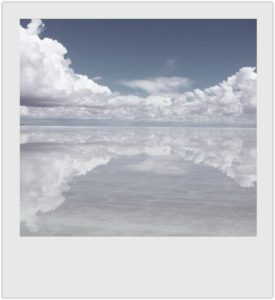 The Salar de Uyuni is the world’s largest salt flat. It is approximately 10,000 km² or 4000 mi.² in size. It is found in the southwest of Bolivia at 12,000 feet above sea level. Bolivia is a landlocked country located in south America. Bolivia has approximately 11,000,000 people and is a pluralistic society. There are people of Spanish, African and Asian descent as well as the local indigenous and mestizo population. The Salar de Uyuni is one of Bolivia’s most popular tourist destinations.
The Salar de Uyuni is the world’s largest salt flat. It is approximately 10,000 km² or 4000 mi.² in size. It is found in the southwest of Bolivia at 12,000 feet above sea level. Bolivia is a landlocked country located in south America. Bolivia has approximately 11,000,000 people and is a pluralistic society. There are people of Spanish, African and Asian descent as well as the local indigenous and mestizo population. The Salar de Uyuni is one of Bolivia’s most popular tourist destinations.
The salt flat was formed as a result of the transformations of several prehistoric lakes. The area has an incredible flatness only broken up by a few small islands. Its unique salt crust covers a pool of brine that is extremely rich in lithium giving it an incredible while color. Approximately 60%-70% of the world’s lithium is found there. The salt was trapped in this area in prehistory as there were no drainage outlets. Just after a rainfall, the thin layer of water on top transforms into the largest mirror in the world. This is a popular time for people to go and take pictures of themselves on the salt flats due to its unique beauty. Tourists can even stay overnight in a hotel built from salt bricks!
In addition to being a popular tourist destination, the salt flat serves as a major transport route across the Bolivian altiplano. The altiplano is a high plateau that was formed during the uplift of the Andes Mountains. It is a harsh environment and there are not many animals or plants that make it their home however one can find several species of flamingos, Andean geese, vicunas, giant cacti and quinoa plants. Lesser known species found there include the Andean fox called a culpeo and rabbit like animals called viscachas.
The name of Salar de Uyuni comes from a combination of the Spanish and Aymara languages. Salar means Salt flat in Spanish and Uyuni means an enclosure. There is a local indigenous legend that the mountains surrounding the area were once giant people named Tunupa, Kuska and Kusina. Tunupa and Kuska were married but Kuska left his wife for Kusina, causing her to cry and her tears turned in the salt flat. As Tunupa is considered an important deity for the local Aymara people, the area is also sometimes called Salar de Tunupa.







